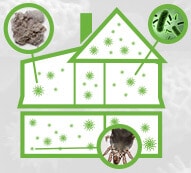
Indoor Air Quality (IAQ) is a term used to describe how the air inside your home affects the people that live in it. EPA studies have recently shone a light on the growing issue of indoor air pollution, ranking it as one of the top 5 health concerns in the United States. These studies show that the air in an average home has between 2 – 10 times more pollution than the air outside. Pollutants are broken up into 5 categories:
- Particles
- Bioaerosols
- Volatile Organic Compounds (VOC)
- Gasses
- Humidity
We are going to break these categories down to show what they are, why you should be concerned, and what you can do to improve your indoor air quality.
Particles
Particles are solids that are light enough to be suspended in air. Common examples of particles affecting indoor air quality are lint, dirt, cigarette smoke, soot from candles, incense smoke, fabric fibers, insect waste, and fiberglass insulation. Particles can enter your home through cracks, attic penetrations, windows, doors, and many other sources.
Particles, particularly fiberglass insulation (which is a suspected carcinogen), can aggravate allergies and asthma and create respiratory health hazards. Long term exposure to these particles can lead to chronic fatigue and other health conditions.
Bio-aerosals
Bio-aerosols are airborne pollutants that are biological in origin. These particles are very small and range in size from less than one micron to one hundred microns. For comparison, a human hair is about 75 microns, meaning most of these Indoor Air Quality pollutants are invisible to the naked eye. Examples of bio-aerosals affecting indoor air quality include bacteria, fungi, viruses, pollen, microbial toxins, dust mites, and animal dander.
Bio-aerosols are known to worsen symptoms related to allergies and asthma. They can also cause nonallergic inflammatory reactions. Although the link has not been conclusively proven, bio-aerosals are suspected to be a cause or contributing factor to Sick Building Syndrome. Sick building syndrome is a phrase to describe many issues including upper-respiratory irritative symptoms, headaches, fatigue, and rash that are caused by a building or residence.
How to minimize harmful particles and bio-aerosals in your air:
- Source Control – In Houston, for nearly every category of Indoor Air Quality source control is the primary choice for improvement. Dry climates have an option for increasing home ventilation but because the air in Houston has such a high humidity level it is not a strong option. Source control refers to eliminating or minimizing the sources of indoor air pollution in your home. For Houston homeowners the largest source of pollution comes from the attic. Your attic is filled with insulation particles, dirt, dust, and many other pollutants. Home’s with leaky ductwork and/or unsealed attic penetrations receive a constant flow of harmful particles and bio-aerosols from the attic. To make things worse, when your AC turns on any duct leakage can pressure your home or attic and put even more harmful particles and bio-aerosals in the air. Air sealed attic and ductwork drastically lower the harmful particles in your air by cutting of the endless supply of air pollutants from your attic.
- MERV 11 or Better Filters – Many HVAC contractors make the mistake of to installing filters before addressing attic and ductwork leakage to address particle elimination. Filters can improve air quality but without addressing source control they are just continually attempting to filter new pollutants from an endless supply. Filters installed after addressing source control are more effective and last longer.
Our next post will cover VOCs, Gasses, and Humidity.

